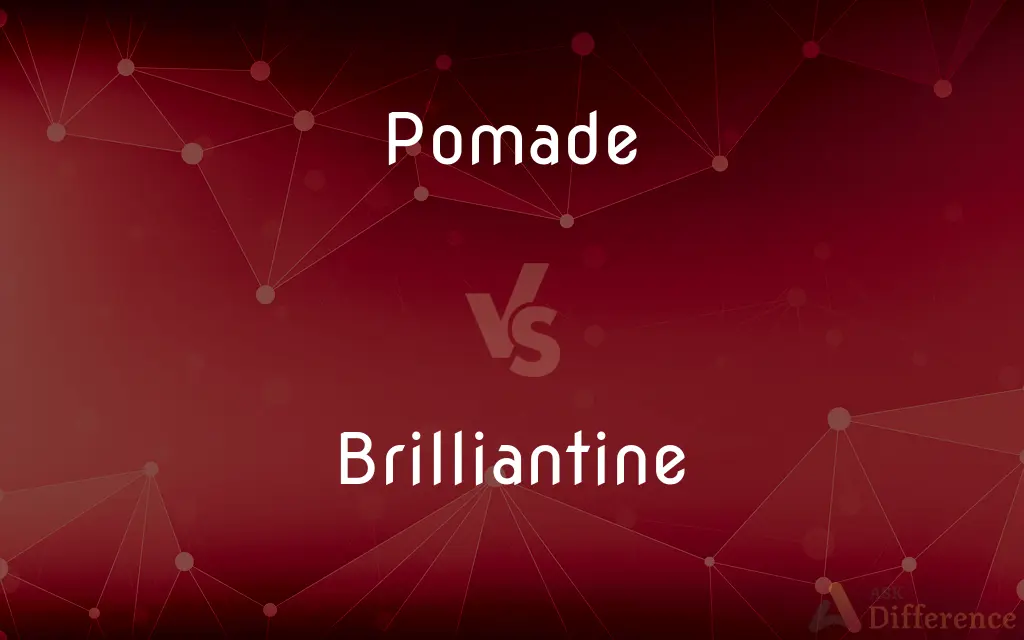Pomade vs. Brilliantine — What's the Difference?
Edited by Tayyaba Rehman — By Urooj Arif — Updated on March 26, 2024
Pomade is a styling product that provides a high shine and strong hold, ideal for slicked-back looks or pompadours, whereas brilliantine is lighter, offering a glossy finish with minimal hold, enhancing hair's natural texture.

Difference Between Pomade and Brilliantine
Table of Contents
ADVERTISEMENT
Key Differences
Pomade, traditionally made from lard or petroleum, has evolved to include water-based formulas, offering a flexible hold with a glossy or matte finish. It's particularly favored for structured hairstyles that require definition and luster, such as classic pompadours or side parts. On the other hand, brilliantine is known for its light texture and is often oil-based, designed to give hair a shiny, wet look without much hold, making it suitable for more casual, tousled styles that appear effortlessly polished.
While pomade is versatile, accommodating both slick, sleek styles and more textured, voluminous looks depending on its formulation (water-based for easier washing out and less grease, oil-based for stronger hold and shine), brilliantine is primarily focused on enhancing the hair's natural appearance. It adds sheen and a slight separation, ideal for achieving a "lived-in" look that's not overly styled.
Pomade users often seek a product that can maintain their hairstyle throughout the day, requiring a certain level of commitment to styling and maintenance, including the potential need for special shampoos to remove oil-based formulas. Brilliantine users, however, typically prefer a low-maintenance approach, achieving a natural shine that suggests health and vitality without the need for frequent touch-ups or special washing considerations.
Another difference lies in the application and distribution through the hair. Pomade, especially in its oil-based form, may require warming up between the hands to soften it for easier application and can be used to sculpt the hair into desired shapes. Brilliantine, being lighter, is effortlessly applied and spread through the hair, often used to finish styles by adding a touch of shine rather than sculpting.
Comparison Chart
Base Ingredients
Lard, petroleum, water (modern versions)
Light oils
ADVERTISEMENT
Hold
Strong (oil-based), flexible (water-based)
Minimal
Finish
Glossy or matte
Glossy, natural
Ideal Hairstyles
Slicked-back looks, pompadours
Tousled styles, natural texture enhancement
Maintenance
Higher (especially oil-based versions)
Low
Washing Out
Challenging for oil-based, easier for water-based
Easy
Application
Can require warming and working into hair
Easy to apply and spread
Styling Preference
Structured, defined styles
Casual, natural looks
User Preference
Those seeking durability and definition
Those preferring a low-maintenance, glossy finish
Compare with Definitions
Pomade
Water-based versions offer flexibility and easier washing.
The water-based pomade allowed him to restyle his hair throughout the day.
Brilliantine
Enhances the hair's natural texture without weighing it down.
A dab of brilliantine brought out the natural waves in his hair.
Pomade
A styling product offering strong hold and shine for detailed hairstyles.
He used pomade to perfect his slicked-back hair.
Brilliantine
A light, oil-based product designed to add shine and a touch of hold.
He applied brilliantine for a subtle, natural sheen.
Pomade
Often oil-based, providing a glossy finish and lasting hold.
His choice of oil-based pomade gave his hairstyle a classic shine.
Brilliantine
Easy to wash out due to its lightweight formulation.
Washing out the brilliantine was hassle-free, requiring just regular shampoo.
Pomade
Requires more effort to wash out, especially the oil-based types.
He needed a deep-cleansing shampoo to remove the pomade.
Brilliantine
Perfect for a casual, tousled look with minimal effort.
For a quick morning routine, he preferred the effortless gloss of brilliantine.
Pomade
Ideal for achieving a polished, groomed look.
Pomade was his go-to for a polished pompadour.
Brilliantine
Suited for those seeking a low-maintenance styling product.
He chose brilliantine for its low-maintenance appeal and natural finish.
Pomade
Pomade (; French pommade) is a greasy, waxy, or a water-based substance that is used to style hair. Pomade generally gives the user's hair a shiny and slick appearance.
Brilliantine
Brilliantine is a hair-grooming product intended to soften men's hair, including beards and moustaches, and give it a glossy, well-groomed appearance. It was created at the turn of the 20th century by French perfumer Édouard Pinaud (a.k.a.
Pomade
A perfumed ointment, especially one used to groom the hair.
Brilliantine
An oily, perfumed hairdressing.
Pomade
To anoint with pomade.
Brilliantine
A glossy fabric made from cotton and worsted or cotton and mohair.
Pomade
A greasy or waxy substance that is used to style hair, making it look slick and shiny.
Brilliantine
A hair pomade, making the hair shine brilliantly.
Pomade
(obsolete) Any medicinal ointment.
Brilliantine
A smooth shiny, luxurious fabric, often of alpaca or vicuña.
Pomade
(transitive) To anoint with pomade; to use pomade to style (hair).
He pomaded his hair until it looked like a piece of shiny plastic.
Brilliantine
To apply brilliantine to the hair.
Pomade
Cider.
Brilliantine
An oily composition used to make the hair manageable and glossy.
Pomade
Perfumed ointment; esp., a fragrant unguent for the hair; pomatum; - originally made from apples.
Brilliantine
A dress fabric having a glossy finish on both sides, resembling alpaca but of superior quality.
Pomade
Hairdressing consisting of a perfumed oil or ointment
Brilliantine
A pomade to make the hair manageable and lustrous
Pomade
Apply pomade to (hair)
Common Curiosities
What's the primary difference between pomade and brilliantine?
Pomade offers strong hold and shine, ideal for structured styles, while brilliantine provides a light, glossy finish with minimal hold for a natural look.
How do you remove oil-based pomade from hair?
Oil-based pomade can be challenging to remove and often requires a deep-cleansing shampoo or a specific pomade-removal product.
Is brilliantine suitable for all hair types?
Brilliantine is suitable for most hair types, especially beneficial for adding shine to dry or dull hair.
Are modern pomades oil-based or water-based?
Modern pomades come in both oil-based and water-based formulations, catering to different styling needs and preferences.
Can brilliantine make hair look greasy?
If used sparingly, brilliantine adds a healthy shine without appearing greasy, but overuse can lead to a greasy appearance.
Does water-based pomade provide a matte finish?
Some water-based pomades offer a matte finish, catering to those who prefer a less glossy look.
How does brilliantine affect curly hair?
Brilliantine can help define curls by adding shine and a slight hold without stiffening the hair, enhancing its natural pattern.
Can pomade and brilliantine be used together?
Yes, they can be used together, with pomade for hold and structure, and brilliantine for added shine and texture.
Is pomade better for short or long hair?
Pomade can be used on both short and long hair, but it's particularly effective for styling shorter, structured hairstyles.
Can brilliantine be used on dry hair?
Yes, brilliantine can be applied to both dry and damp hair, enhancing shine and texture without heavy styling.
How often should you wash hair when using pomade or brilliantine?
Washing frequency depends on the product's base; oil-based products may require more frequent washing, while water-based and brilliantine might not.
Can using pomade lead to hair loss?
Proper use of pomade, especially when washed out regularly, does not lead to hair loss. However, neglecting scalp hygiene can contribute to issues.
Is pomade suitable for sensitive scalps?
Water-based pomades may be more suitable for sensitive scalps, as they are easier to wash out and generally less irritating.
Share Your Discovery

Previous Comparison
Hat vs. Toque
Next Comparison
Leary vs. LeeryAuthor Spotlight
Written by
Urooj ArifUrooj is a skilled content writer at Ask Difference, known for her exceptional ability to simplify complex topics into engaging and informative content. With a passion for research and a flair for clear, concise writing, she consistently delivers articles that resonate with our diverse audience.
Edited by
Tayyaba RehmanTayyaba Rehman is a distinguished writer, currently serving as a primary contributor to askdifference.com. As a researcher in semantics and etymology, Tayyaba's passion for the complexity of languages and their distinctions has found a perfect home on the platform. Tayyaba delves into the intricacies of language, distinguishing between commonly confused words and phrases, thereby providing clarity for readers worldwide.















































